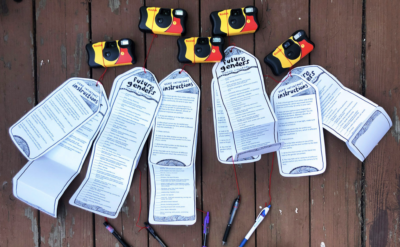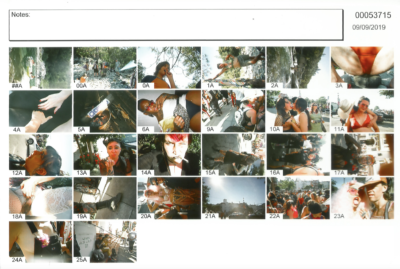The Intersection of Process and Material Outcome in Socially Engaged Work
December 4, 2022
Text by Olivia DelGandio with Zeph Fishlyn
“I want exchange and interaction and I think involving people’s physicality instead of just the way they think creates interesting conversations. There’s a pleasure and engagement piece in it for myself as an artist.”
ZEPH FISHLYN
Before coming to PSU’s Art + Social Practice program, my practice revolved mostly around material objects; I took photos, I painted, I made collages. While I greatly enjoy (and still do) these things, I wanted more from my art practice. I wanted collaboration and conversation, public interaction and personal storytelling. I wanted social practice before I knew what to call it. But sometimes I struggle to figure out where my past interest in material forms fit into my socially engaged present. I still want to make things, but I want to do it with other people rather than alone. How do I create objects in a socially engaged way? What do I do with the subsequent objects? What physical matter comes out of conceptual projects? I hoped to answer some of these questions with Zeph, whose range of work often contains physical materials and objects in some way or another.

Portland, OR. Photograph courtesy of Zeph Fishlyn.

Photograph courtesy of Zeph Fishlyn.
Olivia DelGandio: I want to start by talking about Glimpses of Future Genders and Sum of its Parts. Could you tell me about the ideation process for these projects?
Zeph Fishlyn: Those projects were very experimental in terms of format and engagement and were much more focused on process rather than product. The first version I did was at San Francisco Pride and it felt like a fun experiment to do in a setting where people were already pretty willing to participate in things. So I sent a few disposable cameras off into the crowd with a set of instructions and was super curious about what I might get back. I also really wanted it to be a physical experience where people had to hand something off to one another and then physically mail it back to me using a pre-addressed envelope. It was like an old school, pre-social media experience.
Olivia: That sounds like such a fun experiment. I’m thinking about how you had no idea what you were going to get back. How did you let go of expectations for a certain outcome since you couldn’t control it in the slightest?
Zeph: Well, the first time I did it I was kind of just like “this seems fun” and wasn’t super concerned with the outcome. Of course, I wanted the cameras to come back to me but I was more intrigued by the possibilities that a project like this could hold. I even found some joy in accepting that maybe nothing at all would come of this project.
Olivia: Socially engaged work is so centered on process, this work really exemplifies that. It’s less centered on material outcomes but you did have a collection of physical photos at the end of these projects. What did you do with those?
Zeph: I have them documented on my website but I never really did anything more with them.
Olivia: I think that’s something I struggle with as a social practice artist. I’m always wondering what to do with the results or physical manifestations of a project. Do you have any thoughts on that?
Zeph: In an ideal world, I’d like to have both a project focused on process and also an interesting material outcome. I think it’s especially important to have something physical to share with those who couldn’t engage in the original project.
Olivia: Me too. In looking through your website, I noticed a lot of your projects have a material component to them. Could you talk about the importance of material making in your work?
Zeph: I really enjoy the experience of having something tactile in my hands and the exchange of materials from person to person. I come from a background of visual art so I was definitely more object oriented before coming into the program but I was never interested in things that just sit on a wall as decoration. I want exchange and interaction and I think involving people’s physicality instead of just the way they think creates interesting conversations. There’s a pleasure and engagement piece for myself as an artist.
Olivia: That’s really interesting. I also want to talk about Those We Glimpse. I’m really interested in doing a project focused on queer storytelling and want to know more about your experience with this project. Did you personally talk to everyone who had a story to share and record the stories yourself?
Zeph: No, I worked through a series of installations. The first installation was made of queer stories from my own family and I asked people to write in stories from their own family that alluded to some history of queerness. Then they hung those stories on the installation and the new stories became the core for the next installation where I invited people to come, read these stories, and contribute their own.
Olivia: Did you have a favorite story from that project?
Zeph: There’s one I love about two aunts dying in bed together and it was so simple but it had me picturing whole lives for these women. It really made me think about the power of imagination.
Olivia DelGandio (they/she) is a storyteller who asks intimate questions and normalizes answers in the form of ongoing conversations. They explore grief, memory, and human connection and look for ways of memorializing moments and relationships. Through their work, they hope to make the world a more tender place and aim to do so by creating books, videos, and textiles that capture personal narratives in a caring manner. Essential to Olivia’s practice is research and their current research interests include untold queer histories, family lineage, and the intersection between fashion and identity.
Zeph Fishlyn (they/them) is a Canadian-born, SF Bay Area-based interdisciplinary artist, educator, and cultural organizer. Zeph’s participatory projects, drawings, objects and interventions cultivate social and ideological mutations in urgent times. Zeph is a serial collaborator with groups taking creative action on economic and racial justice, climate change and LGBTQ liberation— including the End of Isolation Tour, Beehive Design Collective, Greenpeace,the San Francisco Anti-Displacement Coalition, the Anti-Eviction Mapping Project, Heart of the City Collective, the PDX Trans Housing Coalition, and the Center for Artistic Activism. They played key roles in creating and maintaining collective spaces for artists and activists, including Lobot Gallery, a live/work/event space, and the 2027 Mutual Aid Society, a resident-run affordable housing co-op.


